Full of festive winter flavours this Christmas Focaccia bread is super light and airy. Packed with chestnuts, stuffing and fragrant sage, one slice simply won't do!

Focaccia is one of my favourite types of bread.
I love it for its versatility and how it can change depending on my mood, dishes I want to serve it with or what flavours I fancy.
This particular Christmas focaccia has been created to showcase festive flavours of chestnuts, stuffing and sage.
Don't be mistaken to think about focaccia only as a side dish or accompaniment to something.
This baby is punchy enough and full of strong flavours to stand its own ground and feed the crowds during festive gatherings.
Easy enough to portion, it makes great little nibble to serve with drinks during Christmas period.
Jump to:
✔️ Why you'll love this recipe
- Really simple to make yet very impressive bread recipe.
- No mixer or long kneading required.
- Great recipe that is easy to adapt, simply change your toppings.
- The best bread ever to enjoy with soup this winter.
- One focaccia goes a long way so perfect nibble to feed the crowd.
📝 Ingredients
Here is what you'll need to make my Christmas Focaccia recipe:

Strong White Bread Flour - It's a go to when baking most breads due to high protein/gluten content which gives us that rise we're after.
Dried Yeast - I recommend quick or easy yeast which you can mix in with your flour, super simple.
Fine Salt - I use pink Himalayan salt but any fine, good quality salt will do.
Extra Virgin Olive Oil (EVOO) - The only oil I ever use for focaccia as it adds so much flavour. You will need some in the dough but also plenty for drizzling.
Lukewarm Water - You want to use lukewarm water when making bread dough as it helps activating the yeast. See more in 💭 Pro Tips below.
Stuffing - I used ready made chestnut stuffing from Merchant Gourmet (UK) as had a pack that needed using up. Feel free to make your own. Check out my homemade sage and onion stuffing that would be perfect here.
Cooked Chestnuts - I've been buying Merchant Gourmet (UK) vacuum packed chestnuts for years now and really cannot fault them (not sponsored). Feel free to use any brand you can get hold of.
Fresh Sage - I chose sage here but other woody herbs like rosemary or thyme will work as well.
Sea Salt Flakes/Crystals - Great for sprinkling on top of focaccia just before baking and more to serve.

🔪 Instructions
Ingredient quantities & detailed instructions to be found in recipe card at the bottom of the post.
In a large bowl mix together strong bread flour with salt and yeast.
***Quick Tip*** When adding salt and yeast to the flour, keep them separate to start with as salt might affect the yeast. Once they're mixed in, it's fine.

Pour in lukewarm water followed by olive oil and start mixing them into the flour with your hand.
The mixture will be very sloppy to start with but keep mixing until all of the flour has been incorporated into the liquid. Bread dough will be very sticky at this point.

Gently oil your hands, and with dough in the bowl gather part of the dough, stretch it and then fold on top.
Rotate the bowl 90 degrees to the right and do another stretch and fold, rotate the bowl again, stretch and fold the dough and so on.
Keep stretching and folding the dough for about 2 minutes.
***Quick Tip*** The dough will be tearing initially but the more you stretch and fold it the more elastic it will become as gluten develops.
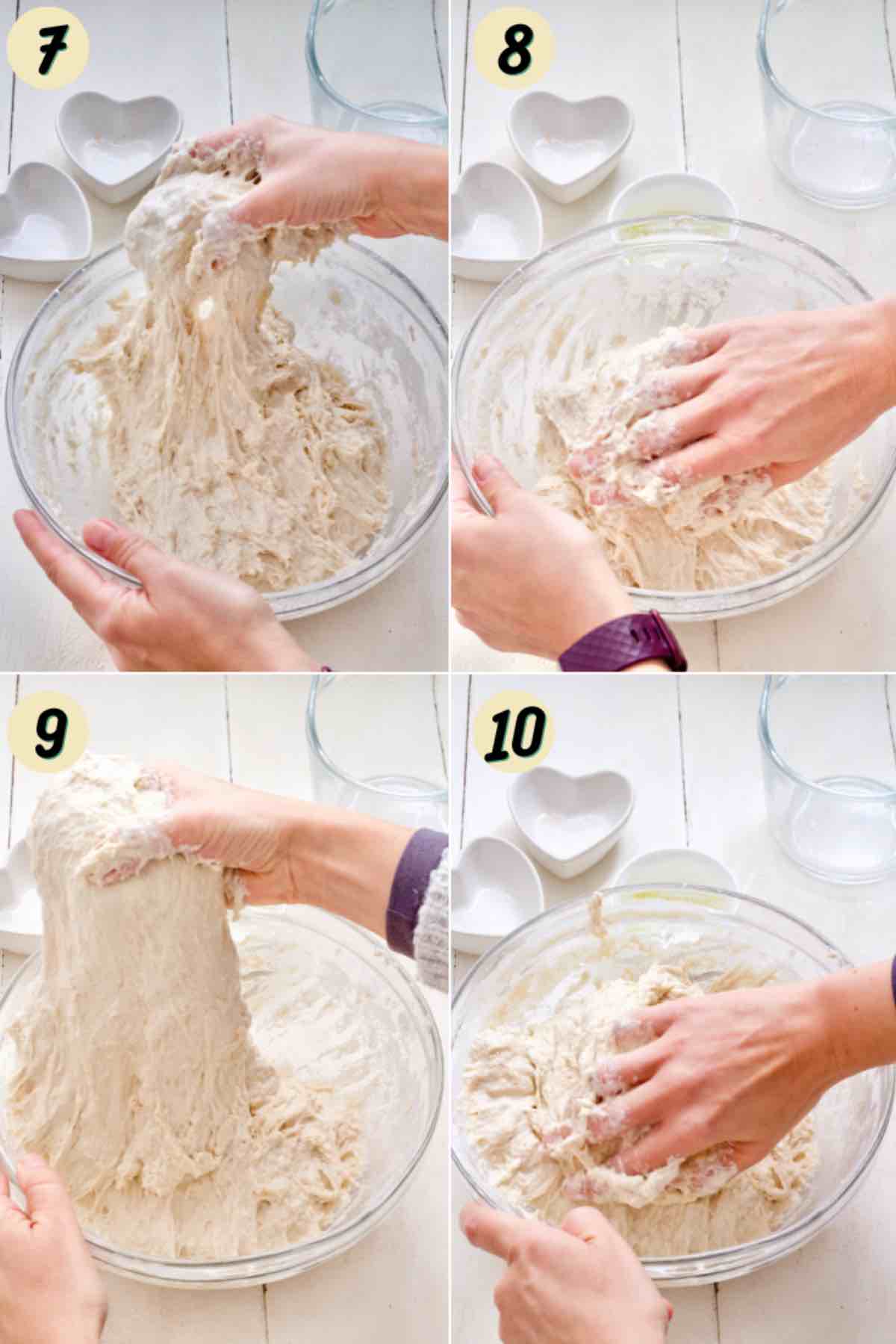
After about two minutes, the dough will still be sticky but more manageable. Gather it into the middle of the bowl, drizzle a little bit of oil on top, cover and put somewhere warm to prove and roughly double in size.
***Quick Tip*** The proving time will depend on the temperature of your surroundings. In winter it usually takes longer than in the summer unless you put it somewhere warm like airing cupboard.

Roughly chop chestnuts and sage leaves and shape your stuffing mixture into small balls/chunks.
Once dough is ready, line baking tray with some baking paper and drizzle over a little bit of olive oil.
Without knocking the dough back (we are trying to keep as much air in the dough as possible) tease it out of the bowl and onto a tray with your hand into an irregular oval shape.
Gently and with oiled hands smooth out the dough slightly so that its surface is pretty even.
Cover and put somewhere warm for about an hour to rest and puff up a bit.
Towards the end of resting time preheat the oven to 200C(fan)/400F/Gas Mark 6.
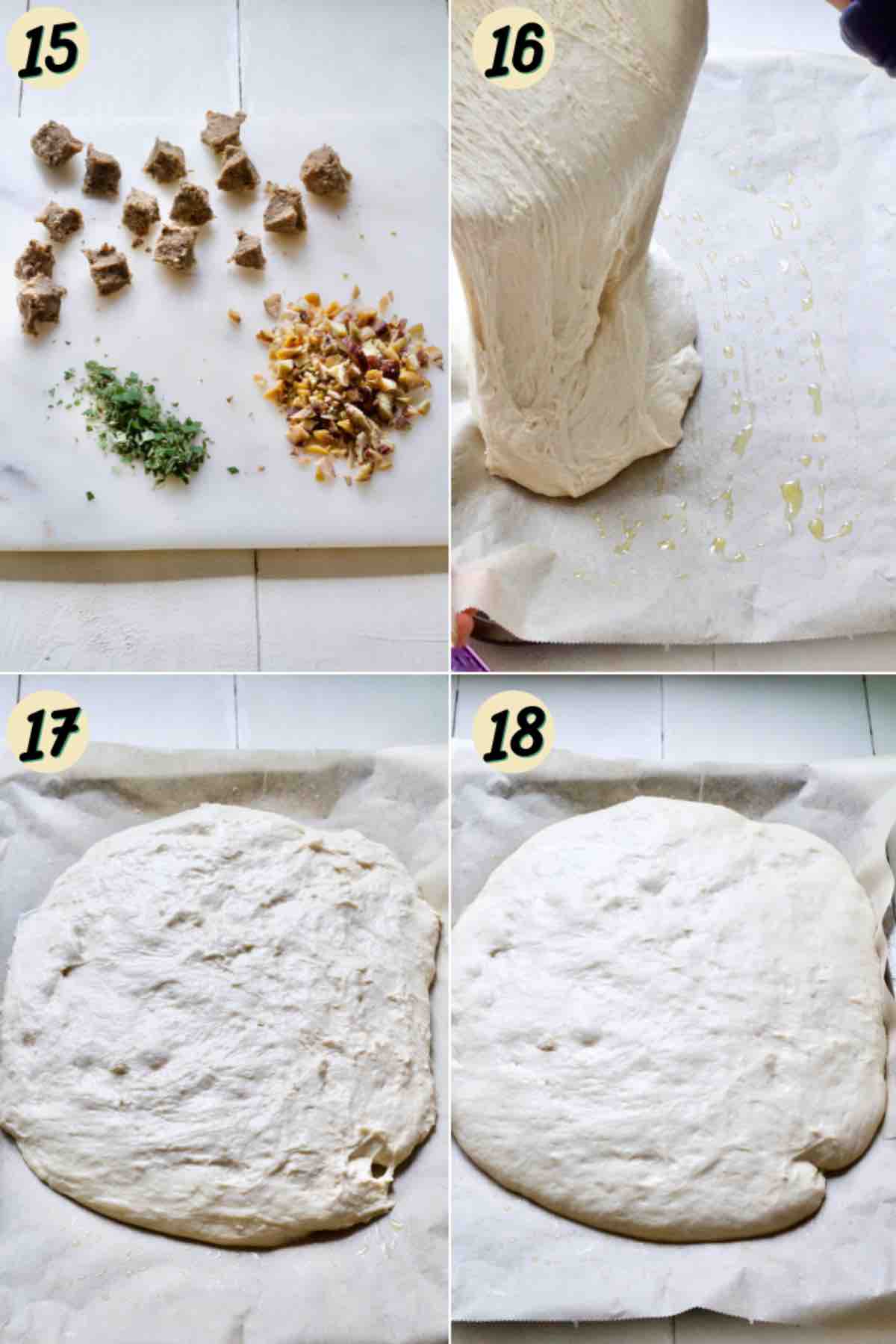
Sprinkle chopped chestnuts and sage over the surface of the focaccia and gently press your oiled fingers into the dough to create little dimples but also to push your toppings into the dough.
Last but not least, place prepared stuffing balls/chunks evenly on top of the dough and press them in gently.
Drizzle over some olive oil, sprinkle over some sea salt flakes and bake in preheated oven for approximately 20 minutes, until golden.
***Quick Tip*** Depending on your oven, you might want to rotate tray with focaccia half way through baking so that it cooks evenly.

It will be really tempting to dig into it the moment it's out of the oven but I would recommend moving focaccia onto cooling rack and letting it rest for at least half an hour first.
This way you won't burn your mouth and it will be easier to slice too.
Enjoy!

💭 Pro Tips
For best results use kitchen scales when weighing out the dry ingredients, unless alternatives are provided (tsp, tbsp).
Use lukewarm or tepid water when making bread dough. It ranges between 36-43C or 98-100F but don't worry too much about it. As long as water is slightly warm and comfortable to the touch, it will be fine.
Hot water kills the yeast so do stay clear!
Do oil your hands whenever advised. Focaccia dough is very sticky from start to finish and oiling your hands will help immensely when handling it.
Good drizzle of extra virgin olive oil over the dough right before baking is essential but make sure you don't overdo it and flood the bread. You can always drizzle more olive oil over the bread before serving.
When it comes to toppings, you don't have to worry too much about quantities which are provided as a guideline. Use more, use less, swap and change, you are in charge and basic focaccia recipe will work with any toppings you choose, Christmas or not.

🥡 Storing
Store: It goes without saying that focaccia is best eaten on the same day it's baked.
However, it will keep (well wrapped) for up to 3 days. I like to store it in a large zip lock style bag I got from Ikea.
Reheat: On days 2 and 3 I tend to pop it in my air fryer for a couple of minutes to give it a little refresh and bring it back to life. Another option is toaster (although you might need to slice it in half to make it fit).
Freeze: Focaccia freezes well. Make sure you wrap it well to prevent freezer burn (I don't use cling film but instead sustainable baking paper and aluminium foil by If You Care (not sponsored).
To defrost simply take it out onto kitchen counter ad it should be thawed in couple of hours. Reheat as per above.

🍴 Serving suggestions
I'll be honest with you. I am a total bread junkie and when it comes to Christmas focaccia I'm happy to enjoy it as is, nothing else needed.
Jokes aside (although I wasn't really joking) it definitely can be served on its own or as part of larger nibble spread to accompany festive drinks. It goes really well with a glass or two of fizz.
Festivities aside, focaccia makes perfect accompaniment to soups.
Try serving it with my curried parsnip soup as a lunch or a starter.
It goes well with any salad too. I love it with a plateful of my Russian salad I grew up eating at most family gatherings, including Christmas.
Use it to make sandwiches. We love it with carrot top pesto and roasted veggies, messy but delicious.
You can also use "slightly past its best" focaccia to make fantastic homemade croutons.

❓ FAQ
Yes you can although personally I find that dough this sticky works much better when using stretch and fold method. It only takes couple of minutes and there is less washing up.
It depends on the temperature in your house. I usually put the bowl with dough in my airing cupboard for the first prove and it takes approximately 1-1.5 hrs.
If I left it on the kitchen counter it would be around 2-2.5 hours.
Once I transfer focaccia dough onto baking tray I usually let it sit on the kitchen counter for about an hour just to puff up a bit, it doesn't need to double in size.
Have you tried my Christmas Focaccia with Chestnuts and Stuffing?
Please consider giving it ⭐️⭐️⭐️⭐️⭐️ rating in recipe card below and share your views or tips in the comments.

📋 Recipe
Christmas Focaccia with Chestnuts and Stuffing
Ingredients
Bread dough
- 500 g strong white bread flour
- 2 teaspoon quick or easy dried yeast (7g sachet)
- 2 teaspoon fine salt
- 2 tablespoon extra virgin olive oil
- 370 ml lukewarm water warm to touch, not too hot
- olive oil for greasing your hands
Toppings
- 100 g stuffing homemade or ready made, shaped into small chunks/balls
- 75 g cooked chestnuts roughly chopped
- 10 fresh sage leaves finely chopped
- extra virgin olive oil for drizzling
- sea salt flakes for sprinkling over and to serve optional
Instructions
- In a large bowl mix together strong bread flour with salt and yeast. ***Quick Tip*** When adding salt and yeast to the flour, keep them separate to start with as salt might affect the yeast. Once they're mixed in, it's fine.500 g strong white bread flour, 2 teaspoon quick or easy dried yeast (7g sachet), 2 teaspoon fine salt
- Pour in lukewarm water followed by olive oil and start mixing them into the flour with your hand. The mixture will be very sloppy to start with but keep mixing until all of the flour has been incorporated into the liquid. Bread dough will be very sticky at this point.370 ml lukewarm water, 2 tablespoon extra virgin olive oil
- Very lightly oil your hands, and with dough in the bowl gather part of the dough, stretch it and then fold on top. Rotate the bowl 90 degrees to the right and do another stretch and fold, rotate the bowl again, stretch and fold the dough and so on. Keep stretching and folding the dough for about 2 minutes. ***Quick Tip*** The dough will be tearing initially but the more you stretch and fold it the more elastic it will become as gluten develops.olive oil for greasing your hands
- After about two minutes, the dough will still be sticky but more manageable. Gather it into the middle of the bowl, drizzle a little bit of oil on top, cover and put somewhere warm to prove and roughly double in size.***Quick Tip*** The proving time will depend on the temperature of your surroundings. In winter it usually takes longer than in the summer unless you put it somewhere warm like airing cupboard.
- Roughly chop chestnuts and sage leaves and shape your stuffing mixture into small balls/chunks.100 g stuffing, 75 g cooked chestnuts, 10 fresh sage leaves
- Once dough is ready, line baking tray with some baking paper and drizzle over a little bit of olive oil. Without knocking the dough back (we are trying to keep as much air in the dough as possible), tease it out of the bowl and onto a tray with your hand into an irregular oval shape. Gently and with oiled hands smooth out the dough slightly so that its surface is pretty even. Cover and put somewhere warm for about an hour to rest and puff up a bit. Towards the end of resting time preheat the oven to 200C(fan)/400F/Gas Mark 6.
- Sprinkle chopped chestnuts and sage over the surface of the focaccia and gently press your oiled fingers into the dough to create little dimples but also to push your toppings into the dough. Last but not least, place prepared stuffing balls/chunks evenly on top of the dough and press them in gently. Drizzle over some olive oil, sprinkle over some sea salt flakes and bake in preheated oven for approximately 20 minutes, until golden.***Quick Tip*** Depending on your oven, you might want to rotate tray with focaccia half way through baking so that it cooks evenly.100 g stuffing, 75 g cooked chestnuts, 10 fresh sage leaves, extra virgin olive oil for drizzling, sea salt flakes for sprinkling over and to serve
- Once ready, take focaccia out of the oven and onto cooling rack to cool for half an hour or so before slicing!
Notes
- Nutritional information is per loaf, without extra olive oil for drizzling and oiling hands and should be treated as a rough guideline only.
- Best eaten on the same day but can be stored for up to 3 days or frozen for up to 3 months. See 🥡 Storing for details.

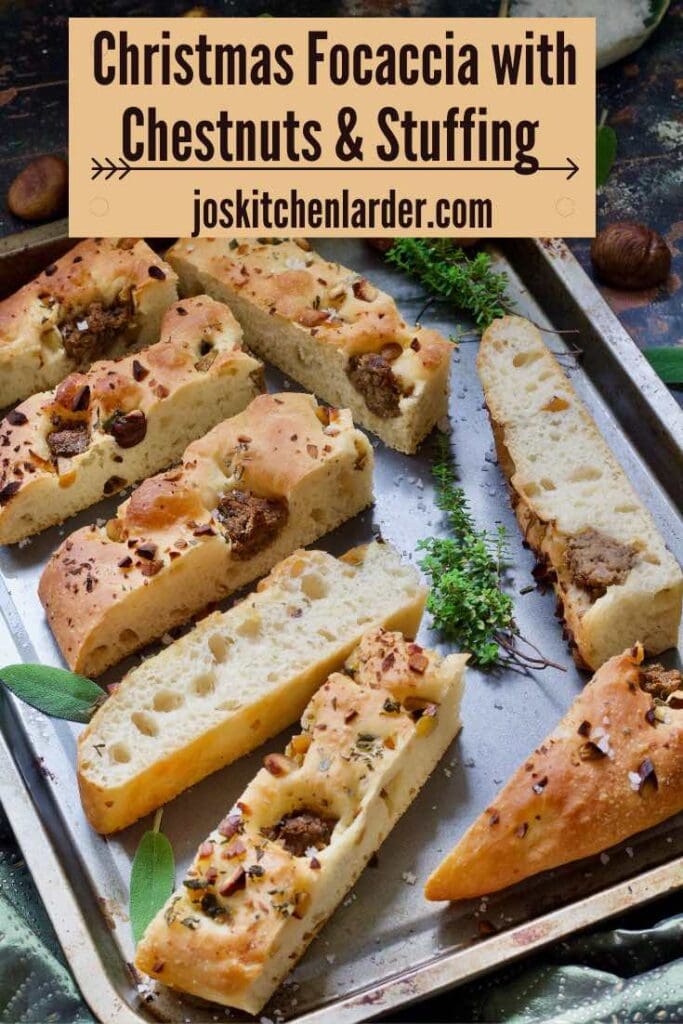
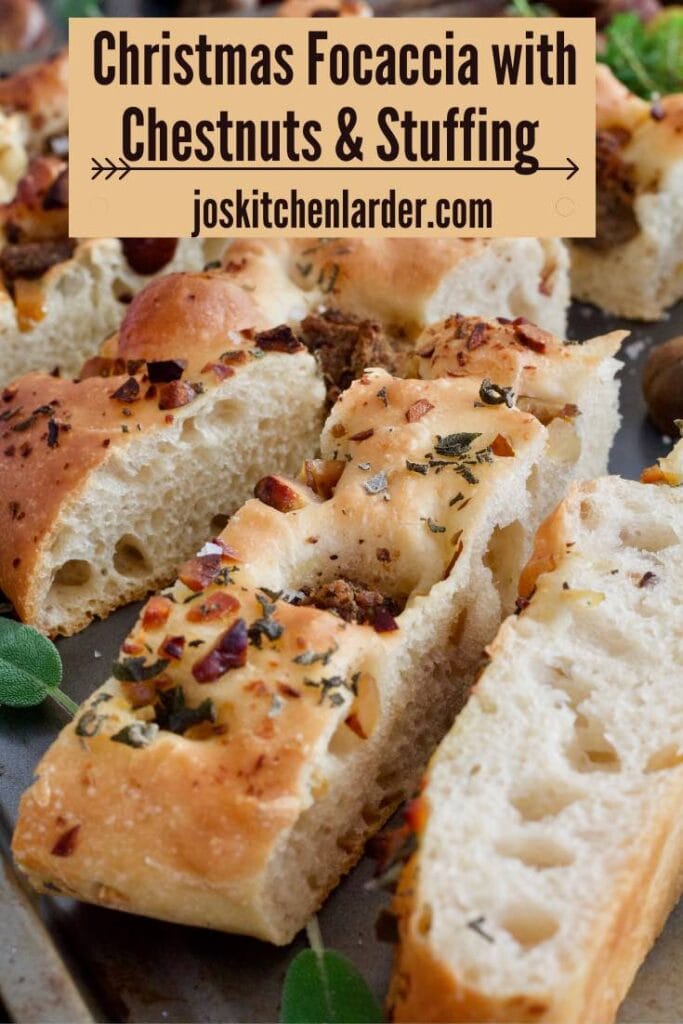
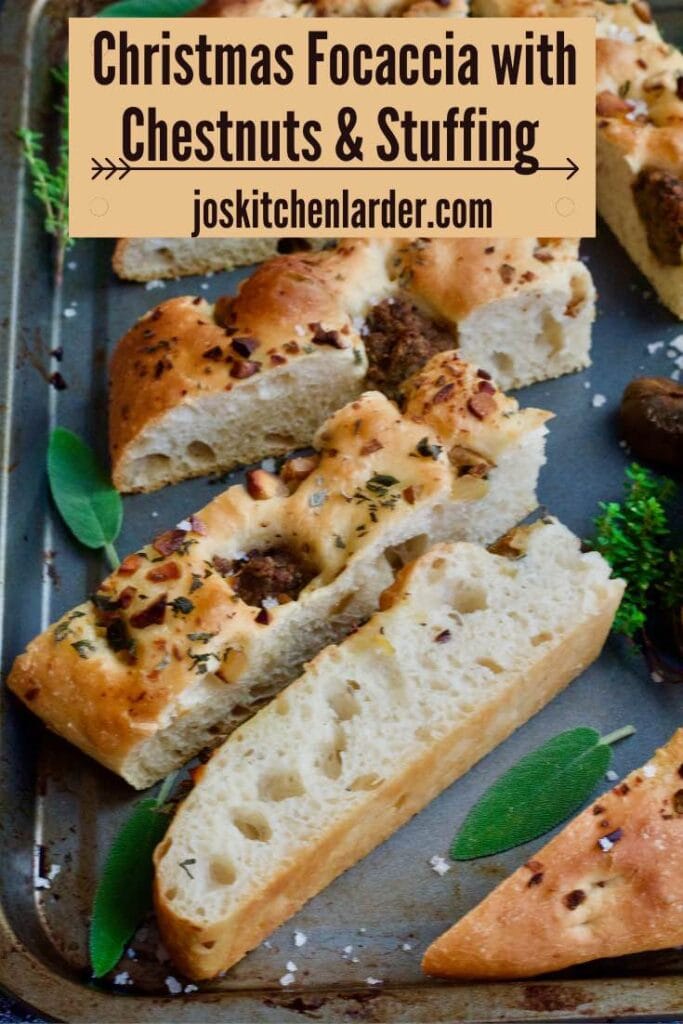






Comments
No Comments